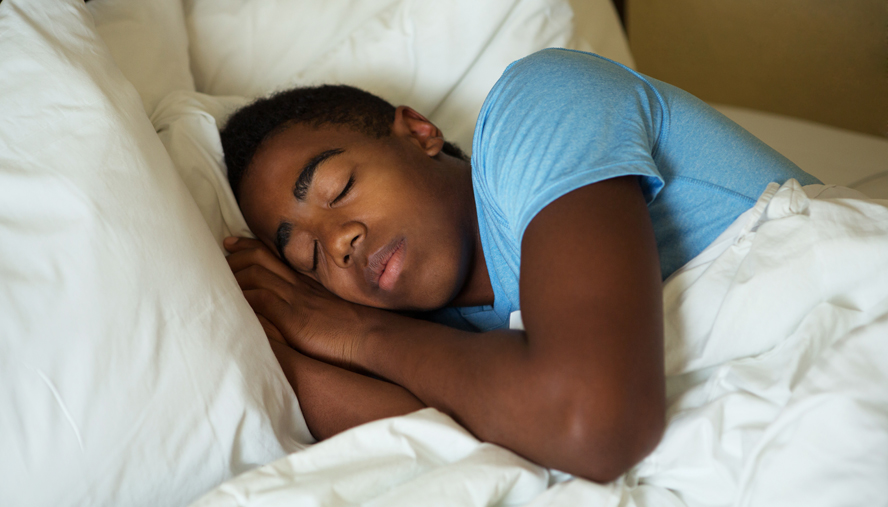Middle and High Schoolers Get More Sleep When Schools Start Later
Students gain half an hour to 45 minutes extra sleep per night
DENVER, CO —
When middle and high schools start an hour later in the morning, students get more sleep and report less daytime sleepiness at school, according to researchers at National Jewish Health. Elementary school students who shifted to earlier start times as part of the school district’s schedule changes had minimal disruptions to their sleep. The benefits of later start times for middle and high school students persisted for 18 months after the change.

“Early school start times are one of the main reasons adolescents are chronically sleep deprived,” said Lisa Meltzer, PhD, professor of pediatrics at National Jewish Health and lead author of the study, which was published April 15 in the journal Sleep. “Sleep changes during puberty, with the circadian clocks of adolescents shifting to a later schedule, making it hard to fall asleep early. By shifting school start times to accommodate their natural sleep rhythm, adolescent students get a half to three quarters of an hour additional sleep each night. Elementary school children, however, are able to go to sleep and wake up earlier, making it easier for them to start school earlier.”
In August 2017, the Cherry Creek School District in suburban Denver delayed high schools by 70 minutes, and middle schools by 40-60 minutes. It started elementary school an hour earlier to accommodate altered demand for school buses. Approximately 28,000 of the district’s 56,000 students and their parents completed surveys several times beginning six months before the change in start times to 18 months after the change.
High school students slept 45 minutes longer per night after the change in start times, increasing to an average of 8 hours and 8 minutes. Students getting sufficient sleep, defined as eight hours for high school students, more than doubled from 30% before the change to 63% after the change. Notably, during the time period of the study the percent of adolescents in the U.S. getting sufficient sleep dropped to 25%. Students often sleep longer on weekends to make up for inadequate sleep during the week. High school students cut weekend oversleep almost in half, from 2 hours and 3 minutes to one hour and 13 minutes. The percentage of high school students reporting daytime sleepiness dropped from 76% to 55%.
Middle school students slept an average of 29 minutes longer after starting school later, going from an average of eight hours and 38 minutes to 9 hours and 7 minutes. The percentage of middle school students getting sufficient sleep, defined as 9 hours, increased from 41% to 61%. Weekend oversleep dropped 32 minutes. Daytime sleepiness dropped from 49% of students to 37%.
Elementary school students slept an average of 11 minutes less per night after starting school an hour earlier. The percentage of elementary students getting sufficient sleep, defined as 9 hours, remained essentially unchanged at 98%. Students reporting daytime sleepiness increased from 35% to 39%.
Changes in sleep were consistent across racial and socioeconomic groups.
“Starting middle and high schools at 8:30 a.m. or later is a critical health policy that can quickly and effectively reduce adolescent sleep deprivation with minimal impact on younger students,” said Dr. Meltzer. “Unfortunately only about 20% of middle and high schools have healthy start times. As sleep is critical for all aspects of student health and well-being, we hope this study motivates more school districts to consider changing start times.”
Cherry Creek School District Superintendent Scott Siegfried said the additional sleep from a later start time has been a game changer for high school students.
“That extra sleep makes a real difference in terms of health and wellness, which in turn supports deeper learning,” said Siegfried. “The input from our students and the numbers from this landmark study point to the same conclusion: The change in our start times has been a positive step and benefited our students’ everyday routines. We are honored to have been a part of this work with National Jewish Health.”
National Jewish Health is the leading respiratory hospital in the nation delivering excellence in multispecialty care and world class research. Founded in 1899 as a nonprofit hospital, National Jewish Health today is the only facility in the world dedicated exclusively to groundbreaking medical research and treatment of children and adults with respiratory, cardiac, immune and related disorders. Patients and families come to National Jewish Health from around the world to receive cutting-edge, comprehensive, coordinated care. To learn more, visit njhealth.org or the media resources page.
Media Resources
We have many faculty members, from bench scientists to clinicians, who can speak on almost any aspect of respiratory, immune, cardiac and gastrointestinal disease as well as lung cancer and basic immunology.
Media Contacts
Our team is available to arrange interviews, discuss events and story ideas.
- Jessica Berry
303.398.1082 office
303.807.9491 mobile
berryj@njhealth.org - Adam Dormuth
303.398.1002 office
970.222.5034 mobile
dormutha@njhealth.org
